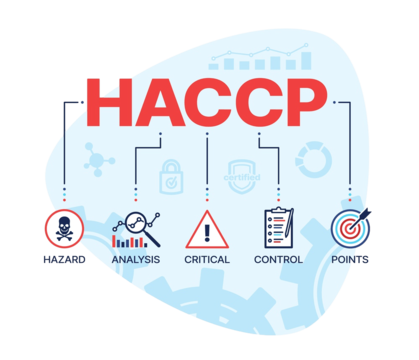It is a management system in which food safety is addressed through the analysis and control of biological, physical and chemical hazards through various stages involved in food production i.e. from production and processing to distribution and consumption.
HACCP is a systematic approach to the identification, evaluation, and control of food safety hazards. It is planned for use in all segments of the food industry right from growing, harvesting, processing, manufacturing, distributing and marketing to preparing food for consumption. HACCP is more of a preventative approach, unlike reactive measures taken after a food-borne illness outbreak.
Definitions:
Hazard: A biological, chemical, or physical agent that is reasonably likely to cause illness or injury in the absence of its control.
Hazard Analysis: The process of collecting and evaluating information on hazards associated with the food under consideration
HACCP Plan: The written document which is based upon the principles of HACCP and which describes the procedures to be followed.
Control Measure: Any action or activity that can be used to prevent, eliminate or reduce a significant hazard.
Control Point: Any step at which biological, chemical, or physical factors can be controlled.
Critical Control Point: A step at which control can be applied and is essential to prevent or eliminate a food safety hazard or reduce it to an acceptable level.
Critical Limit: A maximum and/or minimum value to which a biological, chemical or physical parameter must be controlled at a CCP to prevent, eliminate or reduce to an acceptable level the occurrence of a food safety hazard.
Principles of HACCP:
The HACCP system is based on seven main principles established by the Codex Alimentarius Commission (CAC), an international organization that develops food safety standards.
- Conduct a hazard analysis: To identify potential biological, chemical and physical hazards at each stage of the food production process.
- Determine critical control points (CCPs): Locate the specific points in the process where controlling the hazard is essential for food safety.
- Establish critical limits: Set clear boundaries for each CCP to differentiate between safe and unsafe conditions. (Ex: temperature range for cooking)
- Establish monitoring procedures: Implement methods to continuously monitor CCPs to ensure they stay within critical limits.
- Establish corrective actions: Outline steps to take when monitoring shows a deviation from critical points to prevent hazards.
- Establish verification procedures: Regularly assess the effectiveness of the HACCP plan through audits and sampling.
- Establishing record-keeping and documentation procedures: Maintain records of monitoring, corrective actions, and verification for traceability and future reference.
Advantages of HACCP:
- Aids in reducing risk of foodborne illness outbreaks
- Improving food quality and consistency
- Boosts consumer confidence in food safety
- Developing a streamlined food safety compliance
Conclusion:
HACCP can be applied to all food sectors, from farms and processing plants to restaurants and food service establishments. By adopting HACCP principles, food businesses can significantly reduce the risk of foodborne illness and ensure the safety of their products for consumers thereby promoting reliable food supply.


